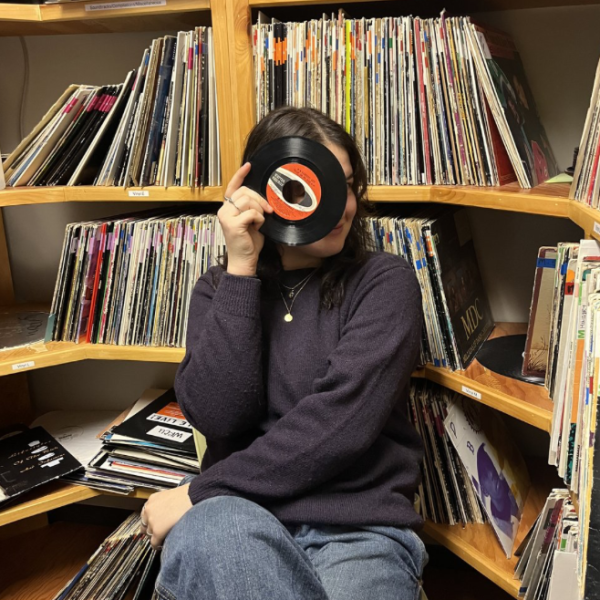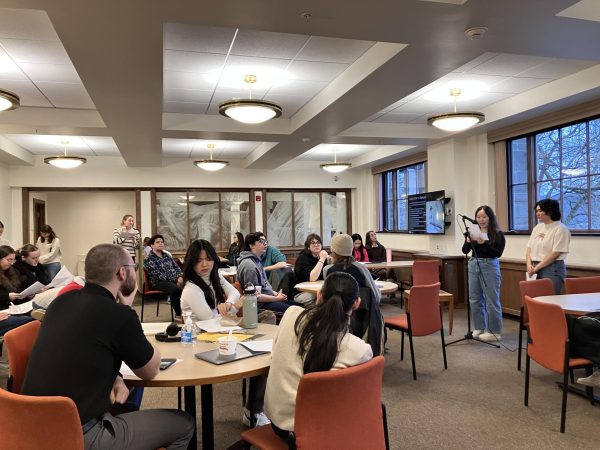A Painting Practice: Layered Landscapes with Elizabeth Flood
In the penultimate lecture of the Fall 2020 Arts and Humanities Colloquium, Visiting Lecturer in Painting Elizabeth Flood discussed important aspects of her practice when painting. Flood’s lecture was titled “Strata, Endurance and Witnessing the American Landscape,” and her work considers the collision of humans and nature. Flood’s work is a unique composite of multiple paintings put together into one, seamless composition of art.
Flood walked the attendees through the five main concepts that she considers in her practice and how those concepts influence how she thinks about what she depicts. These five concepts include: “Landscape as Strata,” “Surveillance/Withering,” “Endurance,” “Communing,” and “Forecasting.”
In her section on Landscape as Strata, Flood outlined how her art was initially influenced by fresco paintings and the horizontal components of art in a town she visited south of Naples, Italy. This style of design raised a question for her:
“Can I make visible all these layers of history and the landscape?”
To fully understand and capture this style, Flood said she had to be in the space she is capturing to fully feel what the people and landscape experienced. To achieve this, the artist chooses to work en plein air and paint on-site to capture the landscapes in front of her.
To add to layers, Flood uses “Surveillance/Witnessing” to capture as many vantage points as possible and create her composite images. These vantage points allow her to capture every detail in a hyper-real image. Flood often paints from high vantage points which, as she said, creates a sense of vigilance, as if she is anticipating something while painting. The added height allows her to create one depth of field in her work, mimicking how it would look at the scene in person.
The “Endurance” that Flood spoke about goes back to the idea of connecting the layers of history and the people who came before her at a location. This process of painting allows her to feel the history, the people and the landscape itself. Flood initially highlighted this concept in one of the images of her work Quincy Quarries, where the history of the quarry and the surrounding community have left a very distinct mark. The quarry was used to acquire stone for Boston, then was left behind, then was used again to create a better road to the quarry, and now the space is a community graffiti park. The layers of how this one quarry has affected and added to the community highlights the “Endurance” of connection between those many facets.
Later, Flood also talked about “Communing” during painting. While working on a piece, Flood is always in conversation with someone — whether it be the painters who were in this spot before her, or her family and friends. Her paintings become “a public work with personal details” as she described, each work containing part of the person or people she was communing with. One tangible example of this was her work in the Fresco Barn in Skowhegan, Maine. Flood was able to create a fresco work there, but the concept of the barn is that eventually, every fresco gets painted over so each artist is creating on top of another, older work. It seems reminiscent of a cycle of rebirth in that the new artists are lifted up by the old.
Finally, Flood spoke of the “Forecasting” aspect of her practice, specifically in the context of her most recent work in Gettysburg. To her, the “Forecasting” aspect is a need to be a witness and to be able to see a situation in real time. “Forecasting” answers the questions: What is this place for? Who is it for? And why?
Recently, Flood went to Gettysburg, Pa. for the 4th of July to paint the scenes and observe the landscape. She said it was very uncomfortable work, and she didn’t know if she could be there or should be there. The other people present at Gettysburg included civilian militias and crowds of Trump supporters, which made her question what it meant to be painting there and what sorts of forgotten stories she could tell.
This work, Flood said, made her feel she could “give agency to land in crisis” and focus with intention on what she is painting and what that tells about the landscapes she works with.
Sophomore Jessie Zehner reflected on the presentation.
“I have Professor Flood for Studio ARTS 100 and through the presentation and thought-provoking discussion in class, you can tell she has such a deep understanding and appreciation for all aspects of arts. It was so incredible to see this deep understanding take form through her own talent,” Zehner said.
When asked what she was going to do next, Flood said she still had a bone to pick with Gettysburg and wasn’t done exploring the painting aspect of that landscape and its history. To her, art becomes a steward of a place; she feels that her art has more to say about that historical location.











